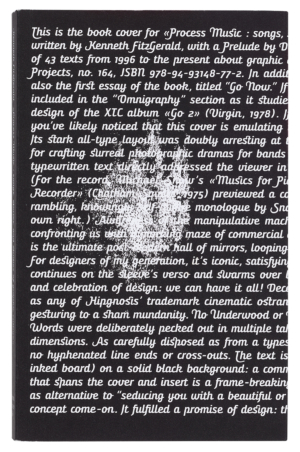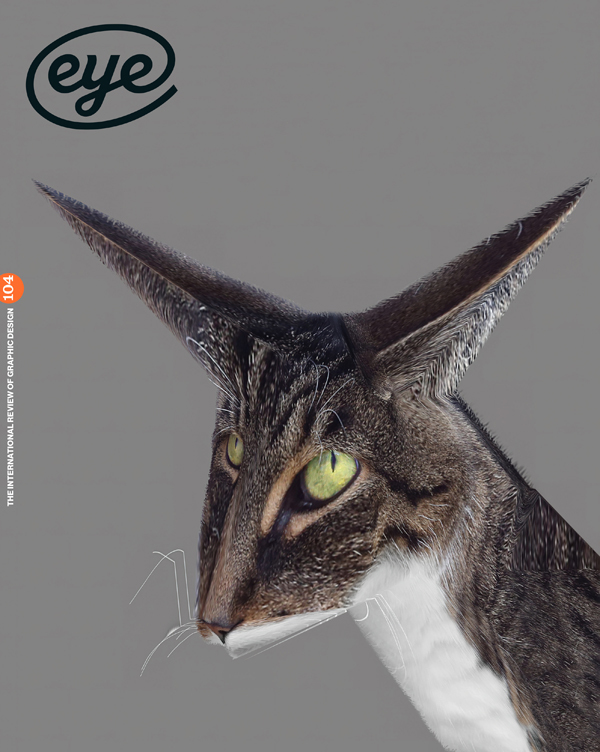Spring 2023
The narrator is present
Process Music: Songs, Stories, and Studies of Graphic Culture
By Kenneth FitzGerald. Published by Onomatopee, €18
Kenneth FitzGerald has been writing about design since 1996, when his first commissioned piece – a review of Elliott Earls’s CD-ROM Throwing Apples at the Sun – was published in Emigre magazine. Since then, his output has covered an impressive medley of subjects relating to design criticism, pedagogy and visual culture. Process Music is the second collection of his writing – FitzGerald’s first was Volume: Writings on Graphic Design, Music, Art, and Culture (Princeton Architectural Press, 2010.)
From the moment you pick up Process Music, you become an active participant. The cover of the shrink-wrapped volume is emblazoned with several reviews from prominent design practitioners. In a short note, Onomatopee explains that this design choice was made on commercial grounds, since the typographic cover ‘might not sell itself in our hasty, visual-oriented culture.’
Once the rave reviews have done their job and the book has been purchased, the reader is encouraged to fold the flaps inwards and reveal the ‘true’ cover: an homage to XTC’s 1978 album, Go 2, designed by Hipgnosis (see Critique, pp.20-21).
The text, set in Bunita Swash, is effectively the first essay of the volume, and questions the cover’s utilitarian, economic and cultural value. By making what is often implicit explicit in a direct and humorous way, FitzGerald acknowledges the complexity in which design operates, providing conceptual framing for the publication – a book of writing on design, for designers who like to read about design.
Spanning 324 pages, the 44 essays are divided into four chapters. First, the reader is introduced to broad issues and key debates in graphic design, including questions on authenticity, authorship, technology, pedagogy and design criticism. The focus of the second chapter is on design practitioners, featuring essays on Mark Andresen (first published in Eye 67), Vaughan Oliver, Stefan Sagmeister, Jacqueline Casey and a detailed study of Barney Bubbles (see Eye 6). The third and largest chapter examines design ephemera: magazines, type specimens, books, protest posters and albums. FitzGerald closes the book with more personal musings on creativity and communication.
What is most interesting about FitzGerald’s work is the skill with which he inserts himself into his writing. The essays explore various narrative models by connecting concepts, references, theories and questions through anecdotes, allegories and metaphors. In ‘Transmission’, he talks about a sign he used to admire on his daily commute, by speculating on the motivations behind its redesign in relation to function, aesthetics, history, gentrification, Modernism, culture and commerce. He then finds out the new design was a form of payment from a cash-strapped customer – a reminder of design’s complexity in seemingly simple circumstances. The titular ‘process music’ becomes relevant here as, exemplifying the writing process as ‘thinking through writing’, he exposes the reader to his thought processes.
FitzGerald’s voice is more present in the first and last sections of the book, where he offers first-hand accounts and reflections. By opening and closing with his own voice, the author reminds us of his role and position as design writer and a human being. This is further exemplified in Debbie Millman’s ‘13 Ways of Looking at Kenneth FitzGerald’, which presents him as a person who is sensitive to the surrounding world.
The
collection does not venture far outside the design canon. With the
rise of publications that celebrate design’s ‘hidden’ figures,
this may seem anachronistic, but Process
Music invites
the reader to pause and participate in the design discourse. The book
does a great job in containing core design issues, themes, figures
and objects by making them accessible through humour, observational
storytelling and self-referential framing. For me, Process
Music was
energising, a reminder that the process of reading and writing is
fundamental to self-reflection, criticism and designing.
Gabriela Matuszyk, designer, writer, editor, London
First published in Eye no. 104 vol. 26, 2023
Eye is the world’s most beautiful and collectable graphic design journal, published for professional designers, students and anyone interested in critical, informed writing about graphic design and visual culture. It is available from all good design bookshops and online at the Eye shop, where you can buy subscriptions and single issues.

